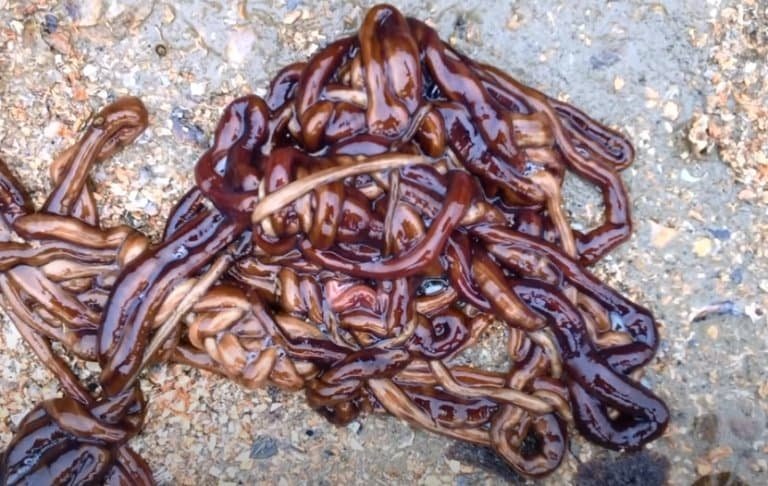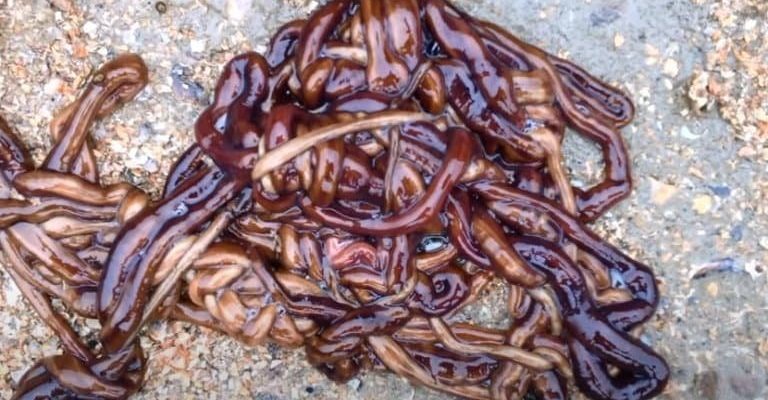
To explain that, let’s start by imagining a dining experience without a kitchen. You’ve got a fancy dinner prepared outside, but instead of a stove, you have a magic cauldron. You toss in your ingredients, and they magically transform into a delicious meal. That’s somewhat similar to how bootlace worms digest their food. They’ve got some extraordinary adaptations that allow them to break down their meals without a traditional digestive setup. Let’s dive into this incredible process together!
What Exactly Is a Bootlace Worm?
Bootlace worms, scientifically known as *Lineus longissimus*, are a type of marine worm that can grow surprisingly long—up to 30 meters! That’s about the length of a blue whale! They usually dwell in sandy and muddy seabeds and are known for their vibrant colors, which can be quite mesmerizing. You might mistake them for a piece of seaweed or rope if you ever see one at the beach.
These worms have a unique body structure. Instead of a solid, segmented form, they have a long, pliable body that wiggles around, allowing them to navigate through their environment easily. Just to add a little drama, when threatened, bootlace worms can break off parts of their body, kind of like a superhero shedding a cloak to escape danger. But how do they find their food and digest it without a stomach? That’s where it gets interesting!
The Digestive Process: Breaking It Down
So, let’s talk about digestion. Most animals have a stomach where food gets broken down by acids and enzymes. In the case of bootlace worms, they use a different method: they secrete enzymes directly onto their prey. Here’s how it goes down:
1. **Finding Prey**: Bootlace worms primarily feast on small invertebrates and organic debris. They’re like nature’s vacuum cleaners, scouring the ocean floor for tasty morsels.
2. **Secreting Enzymes**: Once they find their meal, these worms release powerful enzymes that start breaking down the food right where it sits. It’s like pouring a magic sauce on your food that helps it dissolve into a nutritious drink.
3. **Absorbing Nutrients**: After the enzymes do their job, the worm absorbs the nutrients directly through its skin. This happens through tiny cells in their body, allowing them to soak up vitamins and minerals without needing a stomach.
You might be wondering how efficient this process is. Well, bootlace worms have evolved to be quite effective at it. Their ability to digest food this way allows them to thrive in environments where traditional predators might struggle.
The Role of the Nervous System
Now, let’s dig a little deeper into how these worms manage this impressive feat without a stomach and with a simple nervous system. Bootlace worms have a decentralized nervous system, which means they don’t have a brain like we do. Instead, they have nerve cords running along their body, which help them sense their environment and react quickly to stimuli.
This nerve network is crucial for their survival. Imagine you’re walking through a dark room and suddenly trip over a chair. Your brain quickly processes that signal, and you react to avoid falling. Bootlace worms operate similarly. They can quickly find and react to prey, ensuring they don’t miss out on a meal even in the murky depths of the ocean.
The simplicity of their nervous system doesn’t hinder their survival. Instead, it complements their unique digestion methods, allowing them to function efficiently in their aquatic habitats.
Why Does This Matter? Understanding the Ecosystem
You might be wondering why we should care about how bootlace worms digest their food. Understanding these unique organisms helps us grasp the broader picture of marine ecosystems. Here’s why their digestion process and role in the environment is significant:
– **Nutrient Cycling**: Bootlace worms play a key role in breaking down organic matter. By digesting and recycling nutrients, they help support other marine life. It’s like nature’s clean-up crew, ensuring the underwater world remains healthy.
– **Indicator Species**: Bootlace worms are sensitive to environmental changes. Their presence or absence can indicate the health of their ecosystems. By studying them, scientists can gauge overall ocean health, which is crucial for conservation efforts.
– **Inspiration for Innovation**: Nature often inspires scientific advancement. Understanding how bootlace worms digest their food could lead to breakthroughs in biotechnology, like creating effective enzymes for waste management.
In essence, these little worms are more than just a curiosity; they’re a vital part of the intricate web of life in our oceans.
Exploring Comparisons: Other Creatures Without Stomachs
Bootlace worms aren’t alone in their unique digestive strategies. Several other creatures also manage to thrive without traditional stomachs, and understanding these can give us further insights into evolutionary adaptations.
– **Jellyfish**: Like bootlace worms, jellyfish have no true stomach. They have a gastrovascular cavity that serves multiple functions, including digestion. This simple structure is efficient for their way of life.
– **Starfish**: These exquisite marine creatures also lack a conventional stomach. They can push their stomachs out of their bodies to envelop prey, allowing them to digest from the outside in—quite a creative solution!
– **Flatworms**: Similar to bootlace worms, flatworms absorb nutrients directly through their skin. They have a simple digestive system that works well for their lifestyle.
By comparing these creatures, we can see various evolutionary paths that lead to similar outcomes. Nature is incredibly inventive in its strategies for survival!
In conclusion, bootlace worms are a remarkable example of how life can adapt to its surroundings. Their ability to digest prey without a true stomach showcases nature’s ingenuity. From releasing enzymes to absorbing nutrients directly, these worms manage to thrive in their aquatic environments, playing essential roles in marine ecosystems.
So, next time you find yourself near the ocean, think of those hidden heroes below the surface doing their part to keep things running smoothly. Bootlace worms may not have a pharaoh’s banquet of a stomach, but they sure know how to eat!

